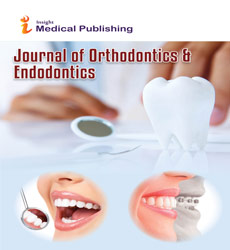Comparative Evaluation of Clear Aligners and Fixed Appliances in Adult Orthodontics
Cahaya Ehsan
Department of Dentistry, Alfonso X El Sabio University, 28691 Madrid, Spain
Published Date: 2025-02-24*Corresponding author:
Cahaya Ehsan,
Department of Dentistry, Universidad Complutense de Madrid, 28040 Madrid, Spain.
E-mail: Rahman.mic@uax.es
Received date: February 03, 2025, Manuscript No. IPJOE-25-20723; Editor assigned date: February 05, 2025, PreQC No. IPJOE-25-20723 (PQ); Reviewed date: February 10, 2025, QC No IPJOE-25-20723; Revised date: February 17, 2025, Manuscript No IPJOE-25-20723 (R); Published date: February 24, 2025.DOI: 10.36648/2469-2980.11.1.02
Citation: Ehsan C (2025) Comparative Evaluation of Clear Aligners and Fixed Appliances in Adult Orthodontics. J Orthod Endod Vol.11 No.1:02
Introduction
Adult orthodontics has seen significant growth over the past two decades, largely driven by increasing awareness of oral health, esthetics and functional correction. Unlike adolescents, adult patients often seek orthodontic treatment with greater emphasis on appearance, comfort and convenience, while still desiring effective results. Traditionally, fixed appliances brackets and wires have been the gold standard for managing malocclusion. However, the advent of clear aligner therapy has reshaped orthodontic practice by offering an esthetically pleasing and removable alternative. As adult patients increasingly prefer discreet options, the comparative evaluation of clear aligners and fixed appliances becomes crucial to guide treatment decisions [1].
Description
Fixed appliances have been the cornerstone of orthodontics for decades, offering precise control over complex tooth movements. They are highly effective in addressing a wide spectrum of malocclusions, including severe crowding, rotations, vertical discrepancies and skeletal issues when combined with adjunctive therapies. The biomechanical principles of fixed appliances allow orthodontists to apply controlled forces and moments through brackets, archwires and auxiliaries such as elastics and springs. Despite their effectiveness, fixed appliances come with challenges, including visibility, oral hygiene difficulties, risk of enamel decalcification and occasional soft tissue irritation. Treatment with braces also typically demands strict patient cooperation, especially in maintaining oral hygiene and may be associated with longer chairside adjustments [2].
Clear aligners, on the other hand, have revolutionized adult orthodontics by prioritizing esthetics, comfort and lifestyle convenience. Fabricated from transparent thermoplastic materials, aligners are virtually invisible and removable, allowing patients to maintain normal eating habits and oral hygiene routines. Digital treatment planning and computer-aided design enable the creation of customized aligner sequences that gradually move teeth with light, controlled forces. Aligners are particularly effective in cases of mild-to-moderate crowding, spacing and certain bite corrections. Features such as attachments, elastics and power ridges enhance their biomechanical capabilities, though challenges remain with movements such as severe rotations, root torque and vertical control. Patient compliance is critical, as success depends on wearing aligners for 20â??22 hours per day and non-compliance can compromise treatment outcomes [1].
From a patient-centered perspective, clear aligners often score higher in terms of comfort, appearance and reduced emergency visits, since they lack wires and brackets that may break or irritate soft tissues. Adults also appreciate the flexibility to remove aligners for special occasions. Conversely, fixed appliances require less patient discipline regarding wear, as they are bonded to the teeth, ensuring continuous force application. Clinical studies suggest that while both systems can achieve satisfactory results in mild-to-moderate malocclusions, fixed appliances remain superior in managing complex orthodontic cases.
Treatment duration varies, with some evidence suggesting aligners may reduce chairside time but not always shorten total treatment length compared to braces [2]. The psychological and social impact of orthodontic appliances is another important consideration in adult patients. Clear aligners often reduce treatment-related stigma and enhance self-confidence during therapy. In contrast, visible fixed appliances may discourage adults from pursuing orthodontic treatment altogether, despite their effectiveness. Cost differences may also influence patient choice, as aligner therapy is often priced higher than conventional braces, depending on case complexity and provider expertise.
Conclusion
Both clear aligners and fixed appliances offer distinct advantages and limitations in adult orthodontics. Fixed appliances remain the most versatile option for comprehensive treatment, particularly in complex malocclusions requiring precise biomechanical control. Clear aligners, however, provide a highly esthetic, comfortable and lifestyle-friendly alternative, making them especially appealing to adults with moderate orthodontic needs. Ultimately, the choice between aligners and braces should be based on individual case requirements, patient preferences, compliance potential and the orthodontistâ??s expertise. As digital technologies continue to refine aligner biomechanics and expand their scope, the future may see aligners achieving parity with braces in managing even the most challenging malocclusions, giving adult patients more personalized and effective options for achieving functional and esthetic smiles.
Acknowledgment
None
Conflict of Interest
None
References
- Hoogeveen EJ, Jansma J, Ren Y (2014) Surgically facilitated orthodontic treatment: a systematic review. Am J Orthod Dentofac Orthop145: S51-64.
Google Scholar Cross Ref Indexed at
- Nambi N, Shrinivaasan NR, Dhayananth LX, Chajallani VG, George AM (2016) Renaissance in orthodontics: Nanotechnology. Int J Orthod Rehabil 7: 139-143.
Open Access Journals
- Aquaculture & Veterinary Science
- Chemistry & Chemical Sciences
- Clinical Sciences
- Engineering
- General Science
- Genetics & Molecular Biology
- Health Care & Nursing
- Immunology & Microbiology
- Materials Science
- Mathematics & Physics
- Medical Sciences
- Neurology & Psychiatry
- Oncology & Cancer Science
- Pharmaceutical Sciences
